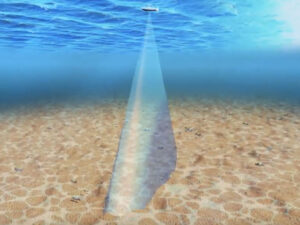Nothing is more frustrating in boating than twisting the starter key and getting a useless click, or switching on the stereo and getting the Ode to Silence. And to many, there is nothing more confusing than the myriad battery choices, both types and sizes, all requiring different maintenance, offering varying benefits and posing unique liabilities. To help unravel some of the voodoo, here is Boating’s primer on making sure you always have 12-volt power and the equipment to refresh it.
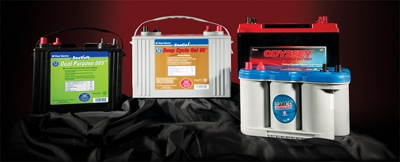
Wet Cell/Flooded Electrolyte(left)
How It’s Made: Flooded cells feature thicker lead and antimony plates surrounded by liquid electrolyte. Marine units are built with thicker plates and extra antimony mixed with the lead, to make them more resistant to shedding and other damage from vibration.
Pros and Cons: Lowest initial investment cost for cold cranking and deep-cycle use, but their construction makes them prone to sulfation. One deep discharge can drastically reduce the battery’s ability to store and give power.
Maintenance: Flooded-cell batteries release a gas that causes the electrolyte to evaporate, leaving plates dry. Monthly additions of distilled water are necessary for keeping them up to snuff. Annually remove cables, clean posts and clean or replace terminals.
Charging: Simple automatic chargers are recommended. Overcharging with a manual charger is destructive to the plates. Batteries discharge rapidly with no load over a few months, so in storage, charging power should be available.
Best Choice When: Low initial investment cost is primary.
Cost and Cost to Own: The West Marine SeaVolt costs from $200. Regular charging and more frequent maintenance add to the cost. Rapid dormant discharge can add to frustration and towing or jumpstarting costs.
Gel Cell(center)
How It’s Made: Many thin plates of lead and calcium are coated with a waxy or gel-like electrolyte and packed tightly together within a sealed case.
Pros and Cons: Ideal as pure deep-cycle batteries, but less than ideal as starting batteries (thin plates may bend under heavy draw) and not as rugged as AGMs.
Maintenance: As in AGM batteries, gels have sealed cells and no monthly electrolyte monitoring is needed. Annually remove terminals and clean and lube connections.
Charging: Gel cells have very specific charging voltage requirements and, while some recommend AGM profiles, they are apt to last longer with charging profiles designed for AGM batteries, often requiring a special charger.
Best Choice When: Superior cycling ability is a plus for deep-cycle use, but low resistance to vibration and lower cranking voltage make them less useful in all but slower moving powerboats.
Cost and Cost to Own: Cost is comparable to that of AGMs without the advantages. The West Marine SeaVolt Gel is $300.
AGM(Absorbed Glass Mat, right)
How It’s Made: A pasty electrolyte bonded to plates pressed between an electrolyte-impregnated glass mat in a sealed box means these batteries can’t spill acid and won’t shed needed plate material from vibration of boating.
Pros and Cons: Maintenance-free sealed cells can’t gas off electrolyte , so you never need to check and top off with water. Fast to recharge, they are kept up to snuff by a short run of the engine. Offers more power in smaller footprints and more versatile installation options.
Maintenance: AGMs are sealed so electrolyte can’t escape and won’t need to be replaced in cells. They need no charging during storage if isolated from current requirement. AGM battery terminals don’t “cold creep,” reducing terminal dimensions, so that annual removal and cleaning may not be necessary.
Charging: AGMs require more voltage and a special charging profile to properly recharge.
Best Choice When: Both cold-cranking and deep-cycle power are demanded from same batteries, since these can be heavily drawn down without damage.
Cost and Cost to Own: EnerSys, Odyssey and Energizer make AGMs ranging from $250 per battery. Ownership costs often negate initial sticker shock, thanks to long life (three to five years) and ability to recover from repeated deep discharges.
Onboard Smart Chargers
Smart chargers can detect the current (voltage) left in a battery, determine exactly how much juice to shoot to it to perfectly recharge it, and then hold it there as long as 110-volt AC power is going to the charger. These chargers monitor the battery or several batteries simultaneously, continually adjusting the charge level or even turning it off, depending on the battery’s need.
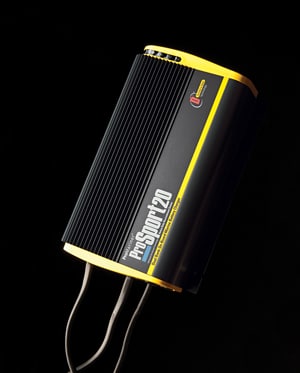
Pro Sport 20
Automatically charges house and cranking batteries while monitoring power levels. Multistage profile decreases current as batteries approach full charge, maintaining but not overcharging.
How It’s Made: Potted circuitry is waterproof, but optimum mounting positions are still above the waterline. A 20-amp output is available for two batteries. LED readouts indicate AC connection and charging status on each battery. Charger dimension: 10.75″ x 7.25″ x 2.5″
Charging Profile: 12- and 24-volt systems for flooded, gel and AGM.
Amps/Watts Output: 20 amps are distributed between two batteries as charger circuitry determines the need.
Tip: All batteries must match in profile.
**
Best Choice When:** Compact mounting in smaller boats and positioning near bilge water is mandatory.
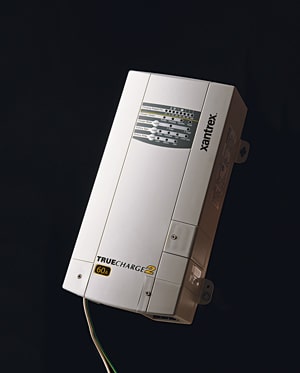
Xantrex Truecharge2
60-amp charger keeps up to three house battery banks perfectly charged after heavy use and long periods of nonuse. A remote controller can be mounted in any convenient area, keeping charger hidden.
How It’s Made: The drip-proof plastic housing protects from spray and splash and features profile-select and charge-mode information on an easy to read panel on the front. A remote control/monitor panel attaches with a cable. Charger dimension: 13.38″ x 6.7″ x 3.54″
Charging Profile: All batteries must be the same type or have the same charging parameters.
Amps/Watts Output: 60 amps total output. Unlike competition, it can recover zero-volt battery.
Tip: Mount above normal bilgewater level since it is not potted for watertightness.
Best Choice When: Power demands call for multiple house batteries to serve heavier household needs, as in cruisers or other overnight craft.
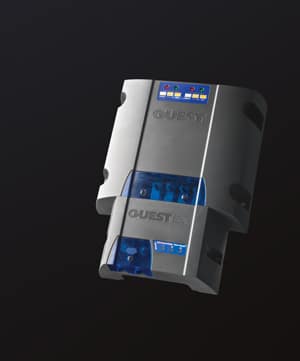
Guest 20-Amp Dual Output Onboard Charger and Alternator Module
On shore power, it monitors all batteries, directing current where most needed. Under way, the alternator module diverts alternator power from a fully charged cranking battery to the house battery.
How It’s Made: Fully potted for watertight performance, this charger can be right at home in a cramped bilge. Without the alternator module, it works only as a 110-volt onboard charger. Charger dimension: 8″ x 8.9″ x 3″ plus alternator mod, 4.1″ x 6.8″ x 2.8″
Charging Profile: Flooded cell
Amps/Watts Output: 10 amps per output
Tip: Mount where LED charge status indicators can be easily seen.
Best Choice When: Charging flooded cell batteries.
Tip: Portable chargers still have their place, but in most boats, a permanent charger left on board solves many logistical problems. It’s often watertight, spark-proof and less prone to creating stray currents. When used dockside it keeps the batteries charging while you’re using them for pumps, lights or whatever. We think that every boat should have one.
Portable Chargers and Jump-Starters
Smaller boats may not have a convenient spot for a permanent charger, and sometimes you just need a backup. Here are examples of charging products we’ve found handy on our boats.
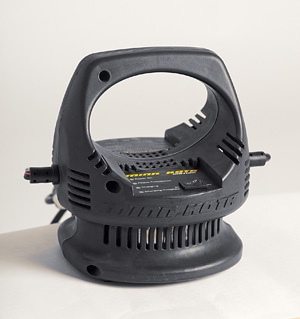
Minn Kota MK 110P
Works By: Monitoring battery status and delivering charge in a dual-stage profile that brings dead batteries back quickly and then maintains them over long periods. One- and two-battery models are available.
Charge Power/Profile: Flooded cell at 10 amps only
Why We Like It: Handy and quick to set up; LEDs indicate charge status or report bad battery if battery has failed or has no detectable current.
Best Choice When: Batteries are carefully maintained and never lose all current. Also handy for mower and off-road toys.
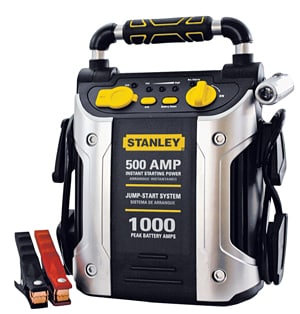
Stanley 500-Amp Jump-Starter
Works By: Combining a small but potent cranking battery in a unit with its own charger. Stanley has added a 120 psi air pump, 12-volt and USB outlets and a trouble light in a compact unit that fits in the trunk and many will stow in a compartment in a boat.
Charge Power/Profile: This device can be charged by plugging it into a wall socket, but its duty is to jump-start a dead vehicle or boat to allow the alternator to take over.
Why We Like It: It provides emergency starting power in a pinch and even roadside assistance for a flat or for other work while en route.
Best Choice When: Anybody needs emergency power for a boat or related electronics.
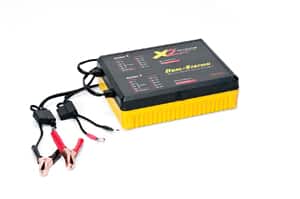
Xtreme Charge Marine
Works By: Electronically monitoring each battery to determine type (flooded- or gel-cell or AGM) and power needs. It additionally determines if battery is recoverable and then uses electronics to monitor and meet charging needs while sending periodic pulses to remove sulfates from battery plates.
Charge Power/Profile: Automatically determines battery type and provides 10 amps of current as needed, dropping power as battery approaches full charge.
Why We Like It: While AGM and gel-cell batteries are less susceptible to sulfation, batteries can recover from sulfation damage. LED readouts indicate viability of battery and charging status. We’ve recovered batteries thought to be extinct with this one.
Best Choice When: It can be permanently mounted in a dry, onboard area or used as a portable. Charger will not charge a completely dead battery, so regular maintenance is required.
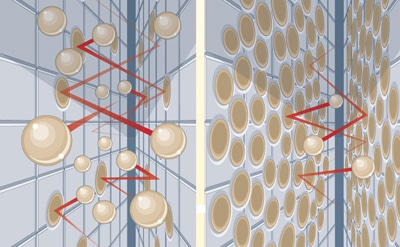
Effects of Sulfating
During discharge, lead can dissolve and form into hard crystals on the battery plates, impeding electrical flow and performance. Fully recharging returns most sulfates back to solution. But here’s the rub: Batteries, especially flooded cells, are often not fully recharged since, as a battery reaches full charge, its resistance increases, decreasing the “charge acceptance rate.” The battery refuses to accept more juice. Current from an almost-charged battery is often not enough to prevent the sulfates from crystallizing, especially deep inside the battery on the inner plates — except in gel and AGM batteries, which are made to combat that effect. But there is a solution, with high-tech chargers offering de-sulfating features as described above.
Tip: Over time batteries lose a percentage of power naturally — even when disconnected. Also, wiring issues, like ground faults, can drain batteries. The two forces can leave your battery dead after just a week or two. Solar chargers that fasten to a hardtop or mooring cover can compensate for that power loss and save the need for a jump-start battery to get your day going.
Do the Math
How much battery capacity do you need? Electrical appliances are rated in either watts or amps, as found in their manuals or on labels affixed to the devices. Add up the total amps required and you can easily size battery needs.
1. Convert the power requirement of all electrical appliances and devices into amps using amps = watts/volts and watts = amps x volts. For instance, a 30-watt microwave uses 2.5 amps, since 30/12 = 2.5.
2. Add up all the devices, estimating the usage time per day for each, and you will have the total “ampacity” — in amp-hours — required of your house battery or batteries (battery bank).
3. It’s then a simple matter to purchase a battery or batteries to suit, since deep-cycle batteries are rated in amp-hours.
4. Add a cushion of 30 percent to the calculation to account for imperfect charging and reduced battery performance with age.
Note: Once you have the daily amp-hour requirement, you should also use it to size the charging system. That is, if you require an estimated 100 Ah use per day, you need to be able to replace that daily need as well. As a practical matter, for us powerboaters, unless we are spending days on the hook, never getting under way, our amp-hour need is less because the engine will be running while many of the appliances are in use.
Solar Charging
Solar power has only in recent years come within reach of boating applications. New technologies for building lighter and more powerful panels make them practical and affordable. Popular uses of solar power include light load acitivities and maintenance charging for batteries when 110-volt power is not available.
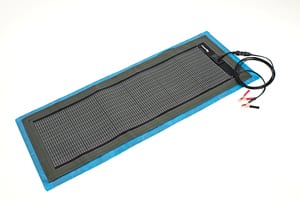
PowerPier R15-600 Flexible Solar Panel
Engineering: Solar circuitry is “printed” on a flexible film. Each tiny solar module is interconnected to the panel in a way that allows the entire panel to function if a tiny module is damaged. The PowerPier generates voltage even on cloudy days, and when coupled with the SunGuard charge controller, it monitors batteries, delivering the appropriate charge to prevent them from discharging.
Charge Profile: PowerPiers are available for one or two batteries and deliver 15.4 volts and 14 watts of charging power.
Tips for Use: PowerPier’s adhesive panel attaches to a mooring cover. Velcro attaches it to the panel, allowing removal for use on other solar needs.
Best Choice When: 110-volt power is unavailable and an unbreakable flexible panel is advisable. $259.99; westmarine.com
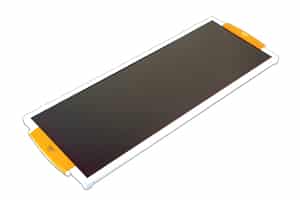
Sunsei SE 1500 Glass Solar Charger
Engineering: Traditional silicone panel construction efficiently creates voltage at 22.5 watts during daylight hours sufficient to provide a maintenance charge to a battery. Can charge through cigarette lighter if not deactivated at key shutoff and need not be disconnected during engine operation.
Charge Profile: Trickle-charges gel and flooded cell batteries at 150 mA in full light — offsetting natural loss.
Tips for Use: Sunsei recommends applying a bead of silcone around the panel frame for extended outdoor use. Can withstand half-inch hail.
Best Choice When: Permanent mounting is possible and less susceptible to breakage. $149.99; westmarine.com
Tip: It’s often quicker to find ground faults, the mysterious eaters of amperage, by simple visual observation. Check for any wires that have drooped into the bilge water or show obvious signs of chafe and wear, and then starting the meter readings with those circuits. Bilge, washdown or livewell pumps are common culprits — but not always.



